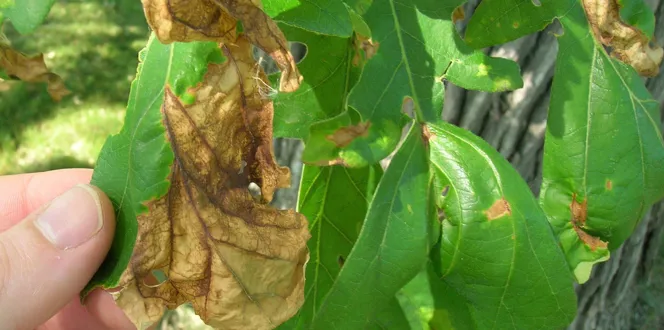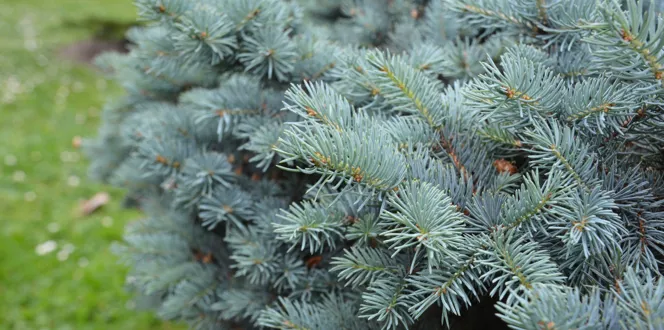In the serene ambiance of your garden, amidst the verdant greenery, lurks a tiny yet formidable adversary – the Viburnum Leaf Beetle.
While viburnums are cherished for their beautiful blooms and lush foliage, this diminutive beetle can wreak havoc on these beloved shrubs, leaving homeowners distressed and perplexed.
Let’s delve into the world of the Viburnum Leaf Beetle, exploring its origins, characteristics, lifecycle, and strategies for how to control Viburnum Leaf Beetle.
Viburnum Leaf Beetle (VBL) Overview
Where did the Viburnum Leaf Beetle come from? The Viburnum Leaf Beetle (VLB), scientifically known as Pyrrhalta viburni, is a species native to Europe and Asia. Initially introduced to North America in the early 20th century, this invasive insect has since established itself as a significant pest, particularly in regions where Viburnums are prevalent.
Its first sighting in the U.S. was in 1996 in New York. It can now be found in much of the eastern U.S., including Connecticut, Maine, New Hampshire, New York, Ohio, Pennsylvania, and Vermont. In 2014, it was discovered across the country in Washington state.
One of the primary pathways for the introduction of invasive species like the Viburnum Leaf Beetle is the movement of infested plant material across borders. Infested nursery stock, landscaping plants, or even hitchhiking on vehicles or cargo can facilitate the dispersal of these pests to new areas.
Susceptible Viburnum Species
When it comes to the Viburnum Leaf Beetle, not all viburnum species are created equal in terms of susceptibility to infestation. Some species are more prone to damage, while others exhibit greater resistance or tolerance to VLB feeding.
Most deciduous species of Viburnums are susceptible including:
- The nonnative European cranberrybush viburnum (Viburnum opulus), including European snowball viburnum and other cultivars.
- The native American cranberrybush viburnum, Viburnum opulus americanum)
- Arrowwood viburnum (Viburnum dentatum), a widely planted native species that is highly susceptible
- Mapleleaf viburnum, Viburnum acerifolium, which is also native.
Resistant Viburnum species
Which viburnum is resistant to leaf beetle? Resistant viburnum species offer a beacon of hope amidst the threat posed by invasive pests like VLB.
Some VLB-tolerant species include:
- Viburnum davidii, an evergreen
- Viburnum carlesii (Koreanspice viburnum)
- Viburnum x juddii (Judd viburnum)
- Viburnum lantana (wayfaring tree viburnum)
- Other species and cultivars with highly pubescent foliage such as Viburnum plicatum tomentosum (doublefile viburnum)
Is There a Certain Time of the Year They Are More Prevalent?
Understanding the Viburnum Leaf Beetle life cycle is crucial for effective management. These beetles overwinter as eggs laid in small clusters on the twigs of viburnum plants. As temperatures rise in spring, usually during April and early May, the eggs hatch into larvae, which voraciously feed on the tender leaves of the host plant.
As the larvae mature, they undergo several molts before pupating. During the pupal stage, they undergo metamorphosis, eventually emerging as adult beetles in June and July. The adults feed on the foliage of viburnums, mating and laying Viburnum Leaf Beetle eggs to perpetuate the life cycle.
Viburnum Leaf Beetle Damage
Viburnum Leaf Beetle damage can be devastating to viburnum plants.
Both larvae and adults feed on the leaves, skeletonizing them by consuming the soft tissue between the veins. Severe infestations can lead to complete defoliation, weakening the plants and making them more susceptible to other stressors such as drought and disease. Repeated defoliation can kill the plant outright.
Other Tree Pests VLB Could Be Confused With
The Viburnum Leaf Beetle shares some similarities in appearance and behavior with several other insect pests, leading to potential confusion, especially for those unfamiliar with these insects. How to get rid of Viburnum Leaf Beetle includes recognizing these lookalike species. Here are a few tree pests that could be mistaken for VLB:
- Cucumber beetles: These common pests of cucurbit crops such as cucumbers, squash, and melons, are small beetles with elongated bodies and distinct yellow and black markings. Unlike VLBs, which exclusively target viburnum plants, cucumber beetles are specialized pests of cucurbitaceous plants and are less likely to be found feeding on trees or shrubs. These pests cause damage to plants by feeding on foliage, flowers, and fruits, as well as transmitting bacterial wilt and cucumber mosaic virus.
- Willow Leaf Beetles: These pests of willow trees and shrubs, including species such as Salix alba (white willow) and Salix babylonica (weeping willow), are small, oval-shaped beetles with metallic green,dark blue, or bronze coloring. Similar to VLBs, willow leaf beetles feed on the foliage of their host plants, often skeletonizing leaves by consuming the soft tissue between veins. Unlike VLBs, which target viburnum species, willow leaf beetles are specialized pests of willow trees and are less likely to be found feeding on other types of plants.
Viburnum Leaf Beetle: Control & Management
Controlling Viburnum Leaf Beetle requires a multifaceted management approach that integrates multiple methods. Here are some strategies for managing this persistent pest:
- Promote plant health through proper watering, fertilization, and pruning. Healthy viburnum plants are better equipped to withstand pest pressure.
- Monitor for eggs that may be laid in twigs. This can indicate an impending infestation.
- Routinely monitor in spring for signs of leaf damage because complete defoliation can occur quickly.
- Once larval feeding is first noticed and larvae are very small (likely in April), apply a foliar spray of narrow-spectrum insecticide effective against leaf-feeding beetles. Repeat this Viburnum Leaf Beetle treatment one to two more times seven to 10 days apart.
- For severe cases or when monitoring for pests is not feasible, consider a systemic insecticide treatment to give the plant season-long protection against this pest.
- To protect bees and other pollinators, avoid spraying viburnums when they are flowering and delay application of soil systemic insecticides until after flowering is complete.
NOT SURE IF VIBURNUM LEAF BEETLE IS A PROBLEM IN YOUR YARD? CONTACT YOUR LOCAL DAVEY ARBORIST FOR A FREE TREE INSPECTION.





